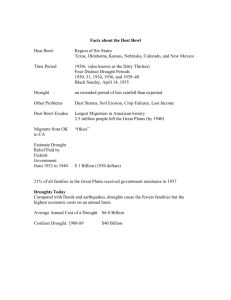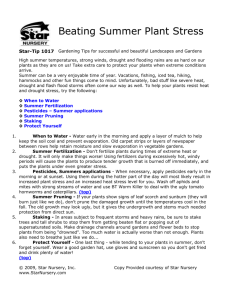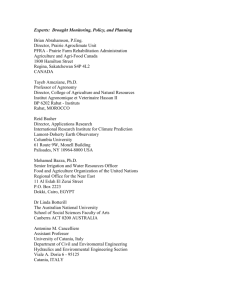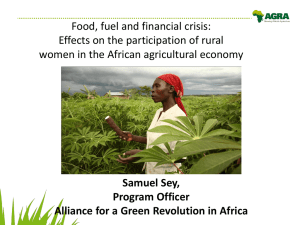Air pollution increases forest susceptibility to wildfires in southern California
advertisement
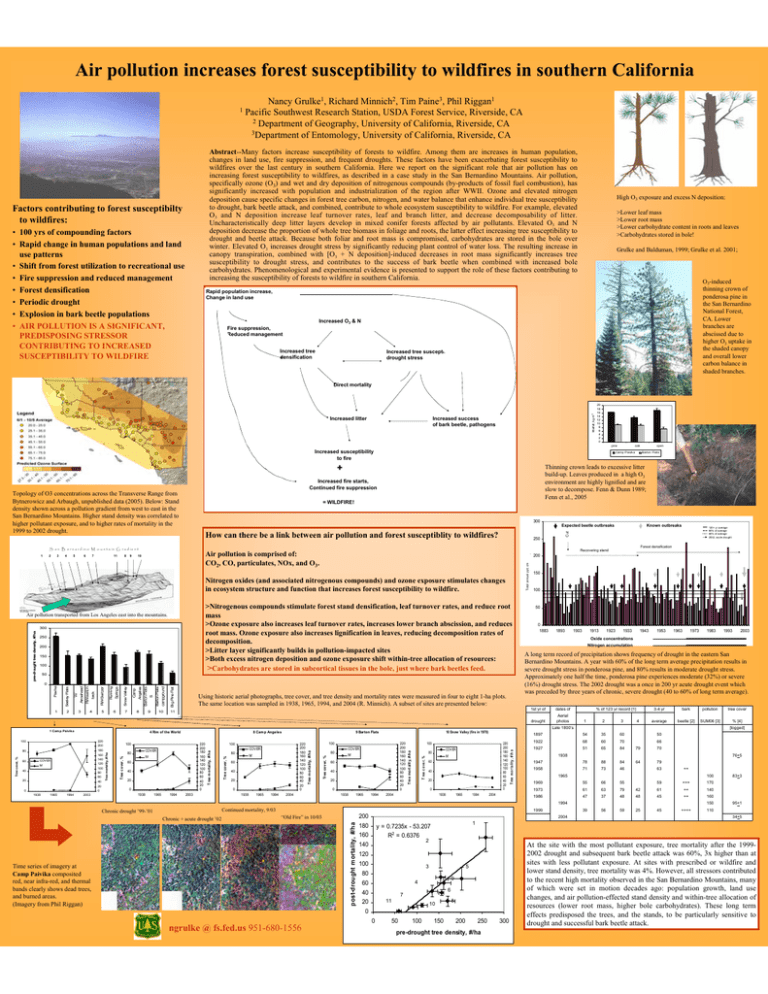
Air pollution increases forest susceptibility to wildfires in southern California 1 Nancy Grulke1, Richard Minnich2, Tim Paine3, Phil Riggan1 Pacific Southwest Research Station, USDA Forest Service, Riverside, CA 2 Department of Geography, University of California, Riverside, CA 3Department of Entomology, University of California, Riverside, CA Abstract--Many factors increase susceptibility of forests to wildfire. Among them are increases in human population, changes in land use, fire suppression, and frequent droughts. These factors have been exacerbating forest susceptibility to wildfires over the last century in southern California. Here we report on the significant role that air pollution has on increasing forest susceptibility to wildfires, as described in a case study in the San Bernardino Mountains. Air pollution, specifically ozone (O3) and wet and dry deposition of nitrogenous compounds (by-products of fossil fuel combustion), has significantly increased with population and industrialization of the region after WWII. Ozone and elevated nitrogen deposition cause specific changes in forest tree carbon, nitrogen, and water balance that enhance individual tree susceptibility to drought, bark beetle attack, and combined, contribute to whole ecosystem susceptibility to wildfire. For example, elevated O 3 and N deposition increase leaf turnover rates, leaf and branch litter, and decrease decomposability of litter. Uncharacteristically deep litter layers develop in mixed conifer forests affected by air pollutants. Elevated O3 and N deposition decrease the proportion of whole tree biomass in foliage and roots, the latter effect increasing tree susceptibility to drought and beetle attack. Because both foliar and root mass is compromised, carbohydrates are stored in the bole over winter. Elevated O3 increases drought stress by significantly reducing plant control of water loss. The resulting increase in canopy transpiration, combined with [O3 + N deposition]-induced decreases in root mass significantly increases tree susceptibility to drought stress, and contributes to the success of bark beetle when combined with increased bole carbohydrates. Phenomenological and experimental evidence is presented to support the role of these factors contributing to increasing the susceptibility of forests to wildfire in southern California. Factors contributing to forest susceptibilty to wildfires: • 100 yrs of compounding factors • Rapid change in human populations and land use patterns • Shift from forest utilization to recreational use • Fire suppression and reduced management • Forest densification • Periodic drought • Explosion in bark beetle populations • AIR POLLUTION IS A SIGNIFICANT, PREDISPOSING STRESSOR CONTRIBUTING TO INCREASED SUSCEPTIBILITY TO WILDFIRE High O3 exposure and excess N deposition: >Lower leaf mass >Lower root mass >Lower carbohydrate content in roots and leaves >Carbohydrates stored in bole! Grulke and Balduman, 1999; Grulke et al. 2001; O3-induced thinning crown of ponderosa pine in the San Bernardino National Forest, CA. Lower branches are abscissed due to higher O3 uptake in the shaded canopy and overall lower carbon balance in shaded branches. Rapid population increase, Change in land use Increased O3 & N Periodic drought Fire suppression, Reduced management Increased tree densification Increased tree susceptibility to drought stress Increased litter litterfall, kg m-2 Direct mortality Increased success of bark beetle, pathogens 20 18 16 14 12 10 8 6 4 2 0 pine Increased susceptibility to fire + = WILDFIRE! 300 3 4 5 6 7 11 8 9 250 Total annual ppt, cm TOTAL ANNUAL PPT, CM 2 Air pollution is comprised of: CO2, CO, particulates, NOx, and O3. 10 Nitrogen oxides (and associated nitrogenous compounds) and ozone exposure stimulates changes in ecosystem structure and function that increases forest susceptibility to wildfire. >Nitrogenous compounds stimulate forest stand densification, leaf turnover rates, and reduce root mass >Ozone exposure also increases leaf turnover rates, increases lower branch abscission, and reduces root mass. Ozone exposure also increases lignification in leaves, reducing decomposition rates of decomposition. >Litter layer significantly builds in pollution-impacted sites >Both excess nitrogen deposition and ozone exposure shift within-tree allocation of resources: >Carbohydrates are stored in subcortical tissues in the bole, just where bark beetles feed. Air pollution transported from Los Angeles east into the mountains. 250 200 150 100 6 8 Big Pine Flat Forest densification Recovering stand 200 150 100 50 0 1883 1893 1903 1913 1923 1933 1943 1953 1963 1973 1983 2003 20 0 1938 1965 1994 2003 M 60 40 20 0 1938 1965 1994 100 220 200 180 160 140 120 100 80 60 40 20 0 COVER 2004 80 M 60 40 20 0 1938 1965 1994 220 200 180 160 140 120 100 80 60 40 20 0 100 COVER 80 T re e c o ve r, % 40 COVER 80 M 60 40 20 0 1938 2004 1965 1994 2004 1st yr of dates of drought Aerial photos % of 123 yr record [1] 4 3-4 yr bark pollution average beetle [2] SUM06 [3] 1 2 3 54 35 60 68 60 70 51 65 84 79 70 1947 78 88 84 64 79 1958 71 73 46 1969 55 66 55 1973 61 63 79 42 47 37 48 48 39 56 59 25 1922 1927 200 “Old Fire” in 10/03 post-drought mortality, #/ha Chronic + acute drought ’02 66 76+5 63 ++ 59 +++ 170 61 ++ 140 45 ++ 160 45 ++++ 1965 Time series of imagery at Camp Paivika composited red, near infra-red, and thermal bands clearly shows dead trees, and burned areas. (Imagery from Phil Riggan) 2004 180 160 100 2 120 100 3 5 80 9 4 60 40 20 6 7 11 10 8 0 0 ngrulke @ fs.fed.us 951-680-1556 50 100 150 83+3 95+1 110 34+5 1 y = 0.7235x - 53.207 R2 = 0.6376 140 % [4] [logged] 1938 1999 tree cover 50 1994 Chronic drought ’99-’01 2003 A long term record of precipitation shows frequency of drought in the eastern San Bernardino Mountains. A year with 60% of the long term average precipitation results in severe drought stress in ponderosa pine, and 80% results in moderate drought stress. Approximately one half the time, ponderosa pine experiences moderate (32%) or severe (16%) drought stress. The 2002 drought was a once in 200 yr acute drought event which was preceded by three years of chronic, severe drought (40 to 60% of long term average). 1986 Continued mortality, 9/03 1993 Oxide concentrations Nitrogen accumulation 1897 T ree m o rta lit y, # /h a 40 20 0 0 60 220 200 180 160 140 120 100 80 60 40 20 0 100 10 Snow Valley (fire in 1970) Tree mortality, #/ha 20 M Tree cover, % 40 220 200 180 160 140 120 100 80 60 40 20 0 COVER 80 9 Barton Flats Tree mortality, #/ha M 100 Tree cover, % 160 140 120 100 80 60 Tree mortality, #/ha Tree cover, % 8 Cam p Angeles Tree cover, % 220 200 180 COVER 1994 Using historic aerial photographs, tree cover, and tree density and mortality rates were measured in four to eight 1-ha plots. The same location was sampled in 1938, 1965, 1994, and 2004 (R. Minnich). A subset of sites are presented below: 11 120+ yr average 80% of average 60% of average 2002, acute drought Late 1800’s 80 1965 10 4 Rim of the World 100 1938 campground S 9 1 Cam p Paivika 60 Barton Flats Angeles Camp 7 Barton Flats Springs Running 5 Snow Valley W RW-Switzer 4 Tree m ortality, #/ha 3 back 2 Arrowhead 1 RW-switch 0 Pavika 50 Seeley Flats pre-drought tree density, #/ha 300 Known outbreaks Cut Expected beetle outbreaks How can there be a link between air pollution and forest susceptiblity to wildfires? S a n B e r n a r d in o M o u n t a in G r a d ie n t 1 open Barton Flats Thinning crown leads to excessive litter build-up. Leaves produced in a high O3 environment are highly lignified and are slow to decompose. Fenn & Dunn 1989; Fenn et al., 2005 Increased fire starts, Continued fire suppression Topology of O3 concentrations across the Transverse Range from Bytnerowicz and Arbaugh, unpublished data (2005). Below: Stand density shown across a pollution gradient from west to east in the San Bernardino Mountains. Higher stand density was correlated to higher pollutant exposure, and to higher rates of mortality in the 1999 to 2002 drought. oak Camp Paivika 150 200 250 pre-drought tree density, #/ha 300 At the site with the most pollutant exposure, tree mortality after the 19992002 drought and subsequent bark beetle attack was 60%, 3x higher than at sites with less pollutant exposure. At sites with prescribed or wildfire and lower stand density, tree mortality was 4%. However, all stressors contributed to the recent high mortality observed in the San Bernardino Mountains, many of which were set in motion decades ago: population growth, land use changes, and air pollution-effected stand density and within-tree allocation of resources (lower root mass, higher bole carbohydrates). These long term effects predisposed the trees, and the stands, to be particularly sensitive to drought and successful bark beetle attack.


